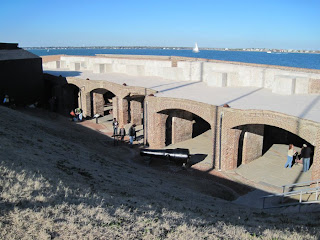 Traveling on US Route #17 on our way to Beaufort, South Carolina we happened upon this historic sign. Both sides of the sign say the same thing, though this side..the back side is far more readable. As we pulled the car over to read and photograph the sign a local farmer hopped off his tractor to tell us about the sign. He was quite chatted and told us an old cemetery lay further back in the brush. He went onto tell us a story that had been handed down to him by his Dad and others in the community. His story, I believe is just that a story. And a wobber at that. Troubling too, as inaccurate things like this story help to keep a wall between Northerns and Southern, help to keep some folks still fighting The Civil War.
Traveling on US Route #17 on our way to Beaufort, South Carolina we happened upon this historic sign. Both sides of the sign say the same thing, though this side..the back side is far more readable. As we pulled the car over to read and photograph the sign a local farmer hopped off his tractor to tell us about the sign. He was quite chatted and told us an old cemetery lay further back in the brush. He went onto tell us a story that had been handed down to him by his Dad and others in the community. His story, I believe is just that a story. And a wobber at that. Troubling too, as inaccurate things like this story help to keep a wall between Northerns and Southern, help to keep some folks still fighting The Civil War.He told us the church was full of people, The Union locked them in, and proceeded to burn it down with them inside. The people were civilians. I thought that pretty unlikely. Though "War is Hell", according to Sherman, and we all know bad things happen in war. Purposely locking civilians in a house of worship and setting fire....I couldn't buy that.
As you can see by the sign it was burnt in 1852 (prior to The Civil War), rebuilt in 1854 and "wrecked" by Union Troops in 1865. Further research indicates Landgrave Edmund Bellinger for whom the community was named for was here. Landgrave was born in England and is buried along with other family members in this old church cemetery. Ashepoo (current community and name of the river is in Colleton County, South Carolina. All my research indicates Sherman's troops burned the church in January of 1865, but no article substantiates the "story" the farmer is spreading.
We had a tight time table and so didn't tromp back through the brush to see the cemetery and church ruins. There had been lots of rain and the ground was a mess, but perhaps on our next trip, we'll get to explore a bit further.
I also found an account of a church being burned in January of 1865 by Sherman called Sheldon Episcopal Church in Beaufort Co. The land was given by the widow of the 2nd Landgrave Edmund Bellinger. One wonders if the stories have been mixed? If, there were 2 separate churches, or perhaps the church went by multiple names.
This was interesting even though we may not really know the whole story or truth of this local with regard to The Civil War because this little church and it's inhabitants played a roll in early Colonial times.













